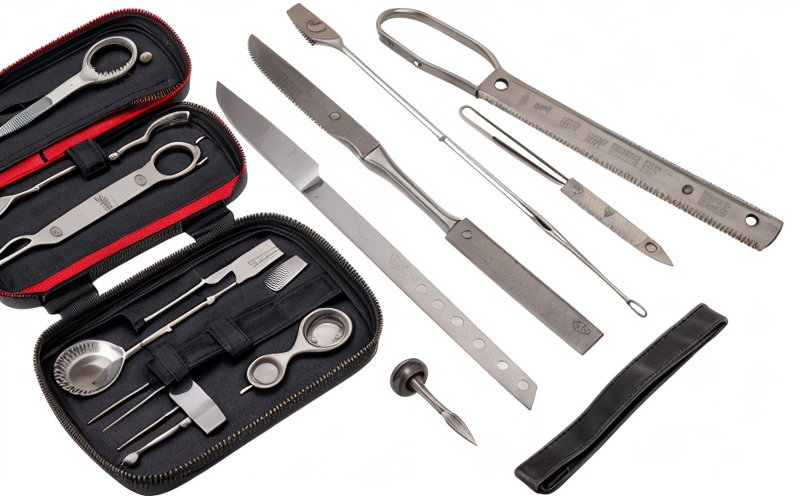ISO 10993-5 Cytotoxicity Testing for Surgical Instrument Coatings
The International Organization for Standardization (ISO) has established a series of standards to ensure that medical devices are safe and effective. One such standard is ISO 10993-5, which addresses cytotoxicity testing for medical device materials. This service is particularly crucial in the context of surgical instrument coatings as it ensures that these instruments do not harm patients during use.
Cytotoxicity testing evaluates whether a material or coating can cause cellular damage when exposed to living tissue. In the case of surgical instruments, this test helps ensure that the surface finishes and coatings used are biocompatible and will not lead to adverse health effects. The testing process is critical for compliance with regulatory requirements such as those set by the European Union's Medical Device Regulation (EU MDR).
The cytotoxicity test involves exposing cell cultures to extracts from the material or coating being tested over a specified period. The change in cellular viability and morphology is then assessed using various methods, including visual inspection, staining techniques, and quantification of metabolic activity.
This service is essential for medical device manufacturers who are developing new products or modifying existing ones. It ensures that all components meet stringent safety standards before being brought to market. Failure to comply with these regulations can result in product recalls, legal issues, and reputational damage.
Our laboratory follows the latest guidelines from ISO 10993-5, ensuring accurate and reliable results. We use state-of-the-art equipment and highly trained personnel to conduct this testing. Our goal is not only to meet but exceed regulatory expectations, providing peace of mind for our clients.
The test involves several steps:
- Sample preparation
- Extraction process
- Culture exposure
- Data analysis and reporting
In conclusion, cytotoxicity testing for surgical instrument coatings plays a vital role in ensuring patient safety and regulatory compliance. By adhering to international standards like ISO 10993-5, we help manufacturers produce safe and effective medical devices.
Scope and Methodology
| Step | Description |
|---|---|
| Sample Preparation | The sample is prepared according to ISO 10993-5 guidelines. This includes cleaning, drying, and cutting the sample into appropriate sizes. |
| Extraction Process | Extracts are obtained from the samples using a specified solvent under controlled conditions. |
| Culture Exposure | The extracts are used to expose cell cultures according to predefined protocols, ensuring consistent and reproducible results. |
| Data Analysis and Reporting | Results are analyzed for cellular viability, morphology, and other relevant parameters. A comprehensive report is generated, summarizing the findings. |
The methodology adheres strictly to ISO 10993-5, ensuring that all tests are conducted under controlled conditions and with precision instruments.
Eurolab Advantages
At Eurolab, we pride ourselves on providing top-tier services for cytotoxicity testing of surgical instrument coatings. Here's why you should choose us:
- Expertise and Experience: Our team comprises highly experienced professionals with extensive knowledge in medical device testing.
- State-of-the-Art Facilities: We are equipped with the latest technology to ensure accurate and reliable results.
- Compliance: We follow all relevant international standards, including ISO 10993-5, ensuring compliance with regulatory requirements.
- Prompt Service: Our efficient processes allow for quick turnaround times without compromising on quality.
- Client-Centric Approach: We prioritize our clients' needs and work closely with them to understand their specific testing requirements.
- Accurate Reporting: Our reports are detailed, accurate, and easy to understand, providing clear insights into the test results.
- Supportive Team: Our team is always available to answer questions and provide guidance throughout the testing process.
We take pride in our commitment to excellence and customer satisfaction. Contact us today to learn more about how we can assist you with your cytotoxicity testing needs.
International Acceptance and Recognition
- Australia: The Australian Therapeutic Goods Administration (TGA) recognizes ISO 10993-5 as a relevant standard for cytotoxicity testing.
- Canada: Health Canada accepts ISO 10993-5 as part of its regulatory framework for medical devices.
- European Union: The European Commission has integrated ISO 10993-5 into the EU MDR, making it mandatory for all manufacturers within the EU to comply with this standard.
- Japan: The Japanese Pharmaceuticals and Medical Devices Agency (PMDA) accepts ISO 10993-5 as part of its regulatory requirements.
- New Zealand: New Zealand's Medicines and Medical Devices Safety Authority recognizes ISO 10993-5 for cytotoxicity testing.
- Singapore: The Singapore Health Sciences Authority (HSA) accepts this standard as part of its regulatory framework.
- United Kingdom: The UK's Medicines and Healthcare Products Regulatory Agency (MHRA) recognizes ISO 10993-5 for cytotoxicity testing.
The widespread acceptance of ISO 10993-5 underscores its importance in ensuring the safety and efficacy of medical devices globally. By adhering to this standard, we ensure that our clients' products meet international standards and are accepted worldwide.





